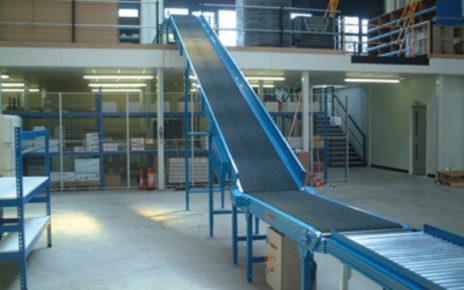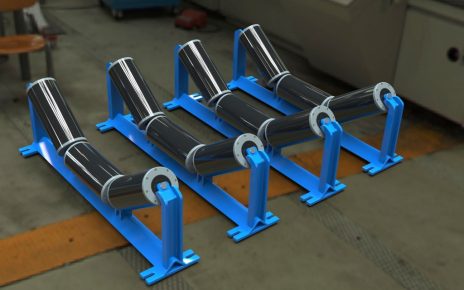Conveyor rollers make lighter work of moving equipment about with minimum effort, and thanks to the engine powered possibilities, they ensure less effort also. From small wheels, belts and inbuilt rollers you can find a great deal of rollers offered on today’s marketplace, whether you decide on a continuous-duty motor or physically powered device.
Rollers are generally used to shift large components, and there are various types of rollers for specific jobs. Rollers and other conveyors have the ability to lift up material, use vibratory motions to relocate products, and hang from above. Some other key types include screw conveyors, chute conveyors and tow conveyors.
Lets take a closer look at some of the main types of conveyor.
Conveyor Rollers
These are handling solutions that use rollers mounted in frames to transfer materials. The factors you should take into account are often the weight potential and height, combined with the conveyor length. Roller conveyors tend to be made use of in handling zones which include loading docks, baggage handling or construction lines. Rollers use gravity or manual power to move goods around and can be straight or bent according to location or working environment.
Powered roller conveyors use powered rollers installed in frames to move merchandise and materials about. The most crucial aspect to consider is the type of drive that you require. The principal drive varieties include belts, chains and motors. Powered roller conveyors have numerous functions, which include food handling, packaging and many other construction line sectors.
Wheel conveyors use unpowered wheels to transport commodities, either by gravitational forces or manual power. If purchasing a wheel system, it is advisable to think about load capability, the actual length and width and the electricity needs. Wheel conveyors are typically used in loading and unloading vans, and also relocating enormous weighty materials such as pallets. Depending on the load specifications, wheel numbers and spacing may differ.
Vibrating conveyors use rotary or linear vibration to relocate merchandise or materials along. They are commonly used to move bulk materials like gravel and coal. Depending on the required use, many sizes are available.
Overhead conveyors are fastened to roofs and make use of carts moved by chains, cabling or other connections. They are usually present in companies where the products has to be hung, including parts handling systems, or for a/c functions. Dependent upon the intended use of the overhead solution, the load transporting capability can be quite critical. Nearly all systems are powered while you can find those that are hand operated.
Belt conveyors use continuous belts to transfer goods. They’re regularly used in food suppliers, for baggage handling, in packaging and in the mail service, even when you would typically associate them with the money registers in stores. Belt conveyors are often powered and operate at a number of speeds. Belts might be used horizontally or even at slope inclines.
Beltless magnetic conveyors employ moving magnets underneath stationary plates to manoeuvre magnetic or ferrous substances. Sometimes it is in the form of scrap metals or equipment parts. Beltless magnetic conveyors can be flat, upright or a mix of both of those.
Uses Of Conveyor Roller Technology
Your personal choice of conveyor system depends upon the item choice, velocity, degree of lift and segment focus specific for your business. Quite a few kinds of conveyor, including belts and vibrating units, can be employed over long distances in industrial sectors such as mining and raw materials. On the other hand, a vibrating belt system would be of little use in food processing or technology businesses.
Conveyors can be hand operated, which is when products are moved along manually on the rollers or wheels. Others are air powered or engine powered. Often, however, they are driven by electrical energy magnetic motors. This either occurs directly or through reduction gears, chains and sprockets.
Materials and goods are typically moved on the top surfaces of conveyors, although overhead conveyors could possibly be the obvious exception.
Roller Supply
If you’re aiming to transfer commodities very easily coupled with minimum energy and effort and the highest possible health and safety, you’ll want to evaluate your needs and requirements thoroughly. Your later judgement will be dependent on the industry sector in which you work, deciding on power source (or otherwise) along with the monetary budget that you’ve got.
Conveyor rollers are perhaps the simplest and flexible system and also one of the most inexpensive. Roller systems are also user friendly and maintain and can be adapted to a array of industrial sectors and uses. Components can be custom-designed to for your available space and rollers can be selected by materials, load capacity, velocity and more. This is why conveyor rollers are amongst the most favoured choices for UK organisations.
This excellent website www.conveyorrollers.co.uk offers quite a bit more info on the subject of Roller Conveyors.
Roller conveyor solutions can be custom-designed from modular components. These include straight sections, curves, transitions, merges, partitioning and a lot more. Makers can provide design ability and design and installation guidance, allowing you to get the most effective solution for your need. They can also provide on-going servicing assistance and spares in order to keep your systems and your company moving.
If it’s time you enlarged your organisation and you wish to improve production, storage, transport or more, then a conveyor roller system might possibly be precisely what you’ve been looking for.




